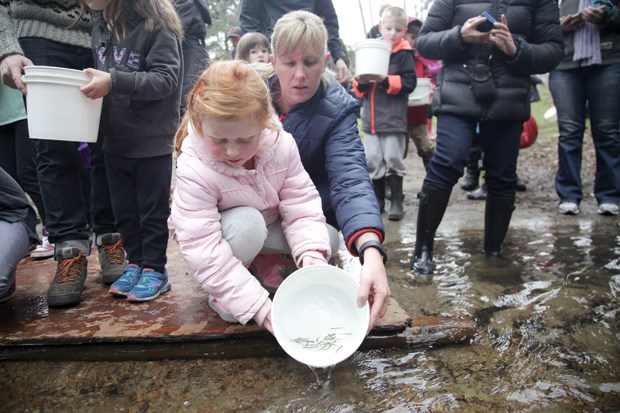The defenders of Mackay Creek beat back the invading forces on Saturday.
Over a span of years they’d lost ground to English ivy, Japanese knotweed, hogweed, and blackberry bushes that extended with Reed Richards-like capacity and threatened to choke out every other plant along the creek.
“There was literally just a wall of invasive plants,” noted Wildcoast Ecological Society representative Krystal Brennan. “Nothing could really get through that barrier.”
However, since 2013, volunteers have been dedicated to going native, weeding and re-weeding the tenacious invaders a few times a week, according to Echo Ecological CEO Tara Matthews.
“We’ve been slowly making our way up Mackay,” she said. “It’s not really a job that volunteers want to commit to.”
But while it can be tough to wrangle volunteers to dredge up knotweed roots, the notion of a planting party drew many shades of green thumb.
“We were hoping for around 30 (workers),” Matthews said.
About 100 volunteers came together Saturday to plant $6,000 worth of cottonwoods, red alders, and flowering plants intended to attract pollinators to Mackay Creek’s riparian areas.
It’s a far cry from the 2015 cleanup in which crews plucked car parts, oil drums and shopping carts from the creek.
Saturday’s volunteers included a host of young families who wanted to show their children exactly what goes into being an environmental steward, noted Matthews.
“We want people to know what we’re doing and get them more engaged.”
The volunteers – which included three classes from Bodwell High School – also planted salmonberry and red huckleberry bushes.
“They don’t spread as tenaciously as the invasive species,” Matthews explained.
The plants also help “anchor the stream bank,” Brennan added.
While fending off the invasive species may take five more years of regular visits and vigilance, Matthews is encouraged by what she’s seen since the days when a concrete cover created both a largely impassable waterway and a salmon smorgasbord for hunting seals.
In addition to doing away with the barrier, work began in 2013 to foster salt marsh plants that can keep the geese at bay.
The work seems to be paying off, according to Matthews.
“We’ve been doing fish surveys … just in the last couple of years we’ve noticed a great increase of fish returns,” she says.
The resurgence hasn’t been confined to fish, according to Brennan. Besides a “bumper run” of coho and salmon, the creek has also become home to an increasing number of songbirds and there’s even been a sighting of a black-tailed deer.
The work is important in the wake of stories of climate change and environmental catastrophe that leave viewers feeling “helpless in their day to day lives,” according to Brennan.
‘It isn’t all doom and gloom after all,” Brennan said. “I know I have actually made a positive difference.”
Brennan also saw the fruits of the difference wrought by other stream stewards.
On Thursday night friends and chums poured thousands of fish fry into the creek.
The chum had been living in a giant tanker in a Heywood Park hatchery.
Artist Ron den Daas described the release as a local initiative intended to shift a global mindset.
“We cannot protect our little region without protecting everywhere,” he said.
Two days later, many of the chum were doing their best to navigate the creek waters, according to Brennan.
“We also saw a number of birds diving so we think they might have been eating some of them; but that is nature,” she said.



